- About
- Organization
- Organization Overview
- Dean’s Office
- Department of Bioengineering and Therapeutic Sciences
- Department of Clinical Pharmacy
- Department of Pharmaceutical Chemistry
- Quantitative Biosciences Institute
- Org Chart
- Research
- Education
- Patient Care
- People
- News
- Events
Pharmacy community lends hand to UCSF COVID-19 vaccine effort
By Levi Gadye / Wed Feb 10, 2021
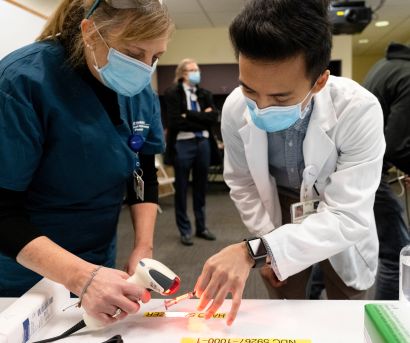
Susan Merrell
UCSF pharmacy student Matthew Aludino, right, scans a dose of the Pfizer COVID-19 vaccine prior to administering it on the first day of vaccinations at UCSF, December 16, 2020.
UCSF pharmacy student Matthew Aludino, Class of 2021, gave over 100 influenza vaccines during the course of his doctor of pharmacy (PharmD) education. So it was a no-brainer that he could lend a hand when UCSF put out a call for volunteers to administer the first COVID-19 vaccinations at the end of 2020—he signed right up.
In some ways it was just another shot, just another carefully-handled syringe, prick, and friendly check-in with the patient. But Aludino’s shot made history, capping off a devastating year with a glimmer of hope.
Throughout the year, as the pandemic ground California’s economy to a halt and ravaged communities across the state, experts had nurtured cautious optimism that an effective vaccine might finally muzzle the virus and slow the loss of life.
As various pharmaceutical companies began testing vaccine candidates in clinical trials in the fall, Lisa Kroon, PharmD, chair of the School’s Department of Clinical Pharmacy, explored how to involve UCSF’s pharmacy students in any eventual vaccination program, as the School had over a decade of experience training students for precisely this role.
Two vaccines for COVID-19 did arrive in December 2020. But to capitalize on these new vaccines, health care providers needed to orchestrate an unprecedented effort to safely and rapidly get them into as many arms as possible.
These new vaccines pose unique challenges—they require storage in ultra-cold freezers, and the vaccination campaign needed to prioritize certain essential and health care workers and vulnerable individuals. Thanks to months of diligent planning, UCSF’s COVID vaccination program hit the ground running within hours of the first doses arriving on campus on refrigerated trucks.
“The pharmacy profession provides immunizers to many communities,” said Desi Kotis, PharmD, chief pharmacy executive for UCSF Health, who helmed the university’s rollout of the COVID-19 vaccines. “Everyone from our students and residents to pharmacists and faculty members stepped up, along with volunteers from the other UCSF schools, to finally give our front-line health care workers and staff some peace of mind on the job.”
A pharmacist at the helm
The novel coronavirus arrived in the San Francisco Bay Area in the spring of 2020, and decisive action by local leaders to lock down the community helped limit its initial spread. By autumn, the region had weathered a summer surge of COVID-19 cases without overwhelming the hospital system, but UCSF experts knew it was no time to let down their guard.
Flu cases normally spike in the winter, so there was concern that COVID-19 cases might similarly take off as colder weather set in. But beyond bracing for another surge of infections, health leaders also started to plan for the eventual arrival of an effective vaccine.

Desi Kotis, PharmD
Vaccines normally take decades to develop, but the ongoing pandemic spurred dozens of pharmaceutical companies worldwide to race to engineer a COVID-19 vaccine. As particular vaccines began to prove their mettle in clinical trials, UCSF administrators like Kotis took note.
“By early October, we knew that the Pfizer and possibly Moderna vaccines were probably going to be the first vaccines out on the market, or at least going to the FDA for emergency use authorization (EUA),” said Kotis.
Kotis was relatively new at UCSF, having started in May 2020, but she had valuable experience orchestrating countless flu vaccine campaigns over the course of her career. In early October, Kotis volunteered to lead UCSF’s effort to distribute the most eagerly awaited vaccine in history.
“I knew this vaccine, and vaccination push, would be totally different from the influenza vaccine campaigns we’re all familiar with,” said Kotis. “But I knew that our pharmacy enterprise would still be critical to safely managing COVID vaccinations, from the hospital to local pharmacies and outpatient clinics.”
Kotis, who is also an associate dean in the UCSF School of Pharmacy, immediately began discussions with colleagues around the university and in the School to ensure all bases would be covered for the incoming COVID vaccine campaign.
In addition to the logistics of receiving, storing, preparing, and giving out vaccines—roles often managed by pharmacists—Kotis was particularly concerned with ensuring the security of the vaccine supply as well as equity in who was vaccinated first. She’d need help from all corners of the university for a successful vaccine campaign.
What it takes to vaccinate during a pandemic
UCSF was already coming off a record year for vaccinations, one that hinted at what would be necessary for a COVID-19 vaccination program. The annual flu vaccine program needed to incorporate masks, sanitation, and ventilation to keep patients and health care providers safe during the pandemic. But outreach to the public was also different. Everyone was urged to get their flu shots with the additional goal of averting a “twindemic”—a bad influenza season concurrent with the pandemic—that could strain the health care system even further.
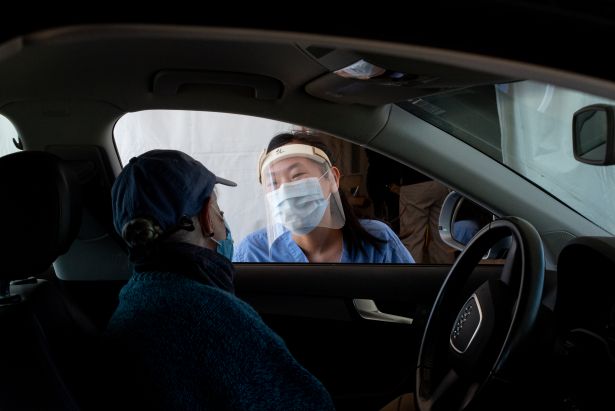
UCSF pharmacy student Susanna Lee talks with a resident during drive-thru COVID-19 testing in rural Bolinas, California. Lessons learned from UCSF's testing efforts have helped inform the university's vaccination planning.
As fall moved on, Kotis regularly met on Zoom with UCSF experts to prepare for the arrival of a COVID-19 vaccine. Robert Kosnik, MD, director of the UCSF Occupational Health Services, provided data from the drive-thru COVID-19 testing sites that UCSF had helped manage, creating a framework for setting up a drive-through vaccination system. Between the successful flu vaccine campaign and the COVID-19 testing program, the group already had a good sense of what it would take to build a COVID-19 vaccination program.
Adrienne Green, MD, chief medical officer of UCSF Health, infectious disease specialist Bryn Boslett, MD, and Sirisha Narayana, MD, chief of the Ethics Consult Service at UCSF Health, were also among the group who helped Kotis map out a plan for quickly immunizing front-line health care workers at UCSF, as well as vulnerable patients. Other on-site UCSF employees and remote employees would follow.
Meanwhile, pharmacy leaders at UCSF worked with Kotis to prepare for the arrival of a never-before-seen vaccine. Kroon, who is also an assistant chief pharmacy officer at UCSF Health, coordinated conversations between the hospital, the School, and state agencies to make sure the UCSF pharmacy community could contribute its collective expertise to the effort.
“Our pharmacy students, staff pharmacists, and faculty at UCSF were already well-versed in running daily vaccination operations,” said Kroon. “The COVID-19 vaccines require special handling and preparation, but otherwise we prepared to do what we were trained to do.”
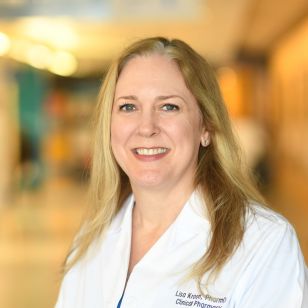
Noah Berger
Lisa Kroon, PharmD
Kroon worked with the directors of the School’s experiential education programs to enable pharmacy students, as well as pharmacy residents, to volunteer as staff for the COVID-19 vaccination campaign without disrupting their educational timelines. She worked with state regulators to expand which health care professionals could supervise pharmacy students in California, maximizing the impact these students could have on the campaign.
And she helped draft guidelines for worst-case scenarios with the vaccines—essentially, how to care for people who have immediate allergic reactions to the vaccine, which fortunately have been exceedingly rare.
“We were able to put an acute allergic reaction protocol together in short order,” said Kroon, “Fortunately, making those types of plans is already part of a pharmacist’s scope of practice.”
Calls were made to the San Francisco Department of Public Health, and UCSF was designated as one of seven sites for COVID-19 vaccination in the state. By November, Kotis was coordinating with other UCs and the UC Office of the President, planning out how to balance the dynamic vaccination needs of different state regions.
“From the get-go, we wanted to ensure equity, an ethical perspective of who receives the vaccines and when, along with the data and the evidence for its efficacy,” said Kotis. “There was a lot of press on ultra cold storage, freezer shortages, but I was thinking more about how we would deploy the vaccine, who gets the vaccine first, how to keep the vaccine secure, and what we’d need to do to react to changes in supply and demand.”
From trucks to freezers to arms
On December 11, 2020, after months of discussion, negotiation, budgeting, and anticipation, the FDA-approved Pfizer’s COVID-19 vaccine with an EUA, signaling to Kotis and her colleagues to assemble the troops and take their marks.
Details about the Pfizer vaccine—how to handle, prepare, and administer the vaccine—were confirmed with the CDC’s Advisory Committee on Immunization Practices (ACIP). As guidelines for UCSF’s handling and administration of the vaccine were finalized, a range of other organizations were consulted, including the California Society of Health-System Pharmacists and American Society of Health-System Pharmacists. Moderna’s COVID-19 vaccine would receive similar FDA approval, and vetting from the same organizations, within days.
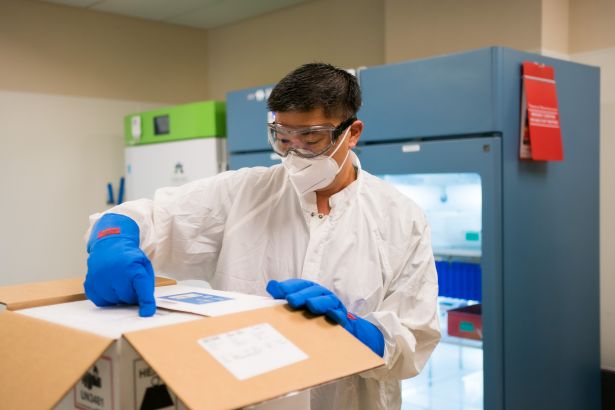
Susan Merrell
Pharmacy purchasing supervisor Robinson Abueg unpacks some of the first frozen batches of the Pfizer COVID-19 vaccine to arrive at UCSF.
Students who had volunteered for the effort, like Aludino, were put on notice.
“In under a week we were up and running, all hands on deck,” said Kroon. “We needed student support to do this. They helped us mobilize these clinics so quickly, the response from learners and pharmacists to this historic moment was incredible.”
Specialized rooms were outfitted with freezers and laboratory benches for efficient reconstitution, or preparation, of the vaccines, which arrived frozen in vials in powdered form and needed to be diluted in liquid for injection. When the Moderna vaccine began to arrive, a color-coded system was implemented to keep track of who received which vaccine—a necessity given that both vaccines would require a matching "booster shot" weeks later.
Meanwhile, Candy Tsourounis, PharmD, faculty member in the Department of Clinical Pharmacy’s Medications Outcome Center, raced to draft monographs, or technical documents, summarizing the safety and efficacy profile of the Pfizer, and later the Moderna, COVID-19 vaccines. These monographs needed to be approved by UCSF’s Pharmacy and Therapeutics Committee and Executive Medical Board before either vaccine could be legally given.
“All we had to work with was the public data we received from Pfizer and Moderna,” said Kotis. “But it was remarkable just how well these vaccines had performed in clinical trials. Both of them were over 90 percent effective in preventing disease, so there was little hesitation to commit to our plans and await the first shipments.”
Front-liners to the front of the line
The first shipments of the Pfizer vaccine arrived on the morning of Wednesday, December 16, a mere five days after receiving FDA approval. Hours later, Aludino sat masked with William Wyatt, a UCSF environmental services worker, holding the University’s first dose of the vaccine, which had been prepared by student and pharmacist colleagues in an onsite pharmacy operations room.
Wyatt works on the front line of the pandemic, cleaning linens in hospital rooms just like he has for over 30 years at UCSF. During the pandemic, his work has been crucial for keeping the hospital clean and safe.
“We started with the highest risk healthcare workers, those working in the wards, the emergency department, the critical care units, all of which actually serve COVID patients,” said Kotis. “We included everybody, not just physicians and nurses, but environmental service workers, patient transporters, patient care technicians, respiratory therapists, phlebotomists, pharmacists, and the students that were on rotation.”
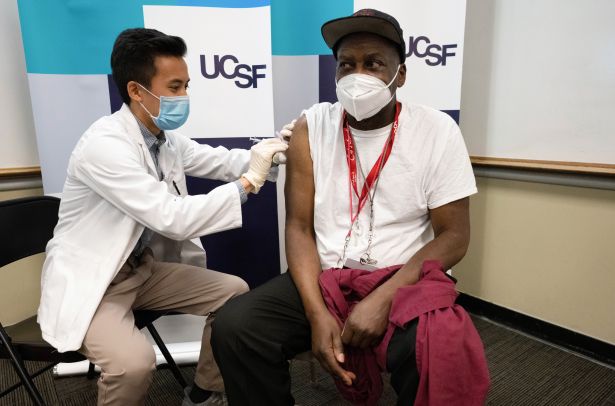
Susan Merrell
Aludino, left, gives environmental services worker William Wyatt UCSF's first dose of the Pfizer COVID-19 vaccine.
Behind the scenes, even the pharmacy staff responsible for preparing the vaccines in the reconstitution rooms were prioritized, to keep the assembly line of volunteers healthy. But Wyatt was the first of the first.
With cameras rolling, Aludino delivered the shot in front of a small audience, including UCSF Chancellor Sam Hawgood. Photos and footage of the historic event were beamed across television screens and the internet, commemorating the beginning of a hopeful end to the pandemic.
Since that day in December, UCSF has administered well over 56,000 vaccinations, primarily to front-line staff, providers, students, and patients over the age of 75, according to Kotis. A drive-thru vaccination site was soon established at City College of San Francisco, enabling UCSF to vaccinate over 2,000 people per day in total, depending on supply. The University is also continuing to balance its internal vaccination needs with those of the city and state.
Nearly 200 pharmacy students and 100 pharmacists have contributed to the rollout of the COVID-19 vaccines, though vaccine administration duties are being handed off to a cadre of occupational health nurses hired specifically for the task. The School of Pharmacy will continue to help staff the pharmacy operations rooms where the vaccinations are prepared, and Kotis will continue to advise the ongoing vaccine campaign in coordination with local and state health care entities.
“This is the type of thing pharmacists can do when we are willing to get involved and practice at the top of our license,” Aludino said. “We can make a difference not just in administering vaccines, but also at the community level, encouraging people to continue safe practices and make sure that this thing doesn’t keep spreading.”
Series
Leading on COVID-19 vaccinations
The School of Pharmacy has been an integral part of UCSF’s efforts to distribute the COVID-19 vaccines. From inoculating patients to educating the public on the safety and efficacy of the COVID-19 vaccines, the School is working to be part of the solution to the coronavirus pandemic.
Check back for our latest coverage of the vaccination roll out.
| Thu Feb 17, 2022 | From haircuts to high blood pressure management |
| Wed Jun 2, 2021 | Answering your questions about the COVID-19 vaccines |
| Mon Apr 26, 2021 | School trains more pharmacists to deliver critical vaccinations |
| Wed Feb 10, 2021 |
This page: Pharmacy community lends hand to UCSF COVID-19 vaccine effort |
| Thu Dec 17, 2020 | How we know it’s safe to get the vaccine |
Tags
Topics:
Category:
Sites:
School of Pharmacy, Department of Pharmaceutical Chemistry, Department of Bioengineering and Therapeutic Sciences, Department of Clinical Pharmacy, PharmD Degree Program
About the School: The UCSF School of Pharmacy aims to solve the most pressing health care problems and strives to ensure that each patient receives the safest, most effective treatments. Our discoveries seed the development of novel therapies, and our researchers consistently lead the nation in NIH funding. The School’s doctor of pharmacy (PharmD) degree program, with its unique emphasis on scientific thinking, prepares students to be critical thinkers and leaders in their field.





